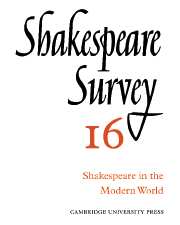Book contents
- Frontmatter
- An Obligation to Shakespeare and the Public
- Our Closeness to Shakespeare
- The Popularity of Shakespeare: An Examination of the Royal Shakespeare Theatre’s Repertory
- Shakespeare and the Fashion of These Times
- An Approach to Shakespearian Tragedy: The ‘Actor’ Image in Macbeth
- Shakespeare’s Impact Today in France
- Shakespeare and the Modern World
- Modern ‘Theatrical’ Translations of Shakespeare
- Shakespeare as ‘Corrupter of Words’
- Shakespeare in Ghana
- ‘Timon of Athens’
- Who Strutted and Bellowed?
- Shakespeare in Planché’s Extravaganzas
- ‘Our Will Shakespeare’ and Lope de Vega: An Unrecorded Contemporary Document
- Shakespeare and the Mask
- International Notes
- Shakespeare Productions in the United Kingdom: 1961
- Acting Shakespeare Today. A review of performances at the Royal Shakespeare Theatre, August 1962
- Canada’s Achievement
- 1 Critical Studies
- 2 Shakespeare’s Life, Times and Stage
- 3 Textual Studies
- Books Received
- Index
- Plate section
An Approach to Shakespearian Tragedy: The ‘Actor’ Image in Macbeth
Published online by Cambridge University Press: 28 March 2007
- Frontmatter
- An Obligation to Shakespeare and the Public
- Our Closeness to Shakespeare
- The Popularity of Shakespeare: An Examination of the Royal Shakespeare Theatre’s Repertory
- Shakespeare and the Fashion of These Times
- An Approach to Shakespearian Tragedy: The ‘Actor’ Image in Macbeth
- Shakespeare’s Impact Today in France
- Shakespeare and the Modern World
- Modern ‘Theatrical’ Translations of Shakespeare
- Shakespeare as ‘Corrupter of Words’
- Shakespeare in Ghana
- ‘Timon of Athens’
- Who Strutted and Bellowed?
- Shakespeare in Planché’s Extravaganzas
- ‘Our Will Shakespeare’ and Lope de Vega: An Unrecorded Contemporary Document
- Shakespeare and the Mask
- International Notes
- Shakespeare Productions in the United Kingdom: 1961
- Acting Shakespeare Today. A review of performances at the Royal Shakespeare Theatre, August 1962
- Canada’s Achievement
- 1 Critical Studies
- 2 Shakespeare’s Life, Times and Stage
- 3 Textual Studies
- Books Received
- Index
- Plate section
Summary
If Shakespeare continues to appeal in the modern world it is because of his peculiar ‘independence’, independence of any intellectual creed, moral or other, which might gain acceptance in one age and lose its plausibility in another. In an important sense, Shakespeare is independent of his time: he does, indeed, express his age perfectly; ‘but he expresses it a little too perfectly to be its child’. And the time he expressed was marked by the intense vitality of the Elizabethans, by their confident and adventurous participation in a world of expanding horizons. It was a time of deep and rapid change, and Shakespeare asserts the significant human values during a period which produced a kind of fusion of Renaissance action with medieval thought. We are still moved by the momentum then generated. Even the Orient, lately awakened and still rubbing her eyes after a night of bad dreams, now feels its pressure. We are again living in a time of deep and rapid change, torn between man’s self-sufficiency and the need to have faith in a power beyond him. In such a time as ours Shakespeare’s steadily human values make special appeal, the more so because the confidence of the earlier day has been replaced by uncertainty, challenge and peril.
- Type
- Chapter
- Information
- Shakespeare Survey , pp. 42 - 52Publisher: Cambridge University PressPrint publication year: 1963



